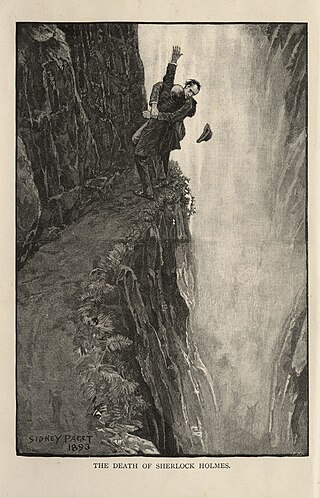
"The Final Problem" is a short story by Sir Arthur Conan Doyle featuring his detective character Sherlock Holmes. It was first published in The Strand Magazine in the United Kingdom, and McClure's in the United States, under the title "The Adventure of the Final Problem" in December 1893. It appears in book form as part of the collection The Memoirs of Sherlock Holmes.

"The Adventure of the Empty House", one of the 56 Sherlock Holmes short stories written by Sir Arthur Conan Doyle, is one of 13 stories in the cycle collected as The Return of Sherlock Holmes. It was first published in Collier's in the United States on 26 September 1903, and in The Strand Magazine in the United Kingdom in October 1903.

"The Adventure of the Bruce-Partington Plans" is one of the 56 Sherlock Holmes short stories written by Sir Arthur Conan Doyle. It is one of eight stories in the cycle collected as His Last Bow (1917), and is the second and final main appearance of Mycroft Holmes. It was originally published in The Strand Magazine in the United Kingdom and in Collier's in the United States in 1908.
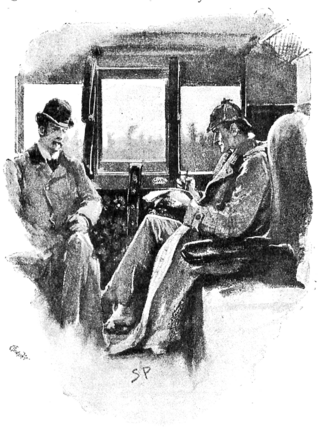
"The Boscombe Valley Mystery", one of the fifty-six short Sherlock Holmes stories written by Sir Arthur Conan Doyle, is the fourth of the twelve stories in The Adventures of Sherlock Holmes. It was first published in the Strand Magazine in October 1891.
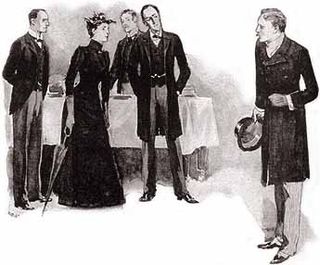
"The Adventure of the Noble Bachelor", one of the 56 short Sherlock Holmes stories written by Sir Arthur Conan Doyle, is the tenth of the twelve stories collected in The Adventures of Sherlock Holmes. The story was first published in The Strand Magazine in April 1892.

The Valley of Fear is the fourth and final Sherlock Holmes novel by British writer Arthur Conan Doyle. It is loosely based on the Molly Maguires and Pinkerton agent James McParland. The story was first published in the Strand Magazine between September 1914 and May 1915. The first book edition was copyrighted in 1914, and it was first published by George H. Doran Company in New York on 27 February 1915, and illustrated by Arthur I. Keller.

Detective Inspector G. Lestrade, or Mr. Lestrade, is a fictional character appearing in several of the Sherlock Holmes stories written by Arthur Conan Doyle. Lestrade's first appearance was in the first Sherlock Holmes story, the novel A Study in Scarlet, which was published in 1887. The last story in which he appears is the short story "The Adventure of the Three Garridebs", which was first published in 1924 and was included in the final collection of Sherlock Holmes stories by Doyle, The Case-Book of Sherlock Holmes.
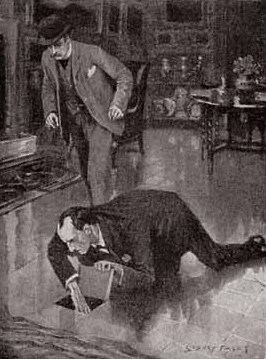
"The Adventure of the Second Stain", one of the 56 Sherlock Holmes short stories written by Sir Arthur Conan Doyle, is one of 13 stories in the cycle collected as The Return of Sherlock Holmes (1905) and the only unrecorded case mentioned passively by Watson to be written. It was first published in The Strand Magazine in the United Kingdom in December 1904, and was also published in Collier's in the United States on 28 January 1905. Doyle ranked "The Adventure of the Second Stain" eighth in his list of his twelve favourite Holmes stories.

"The Adventure of the Cardboard Box" is one of the 56 short Sherlock Holmes stories written by Sir Arthur Conan Doyle. The story was first published in The Strand Magazine in the United Kingdom in January 1893, and in Harper's Weekly in the United States on 14 January 1893. It is the second of twelve stories collected in The Memoirs of Sherlock Holmes in most British editions of the canon, and the second of the eight stories from His Last Bow in most American versions.
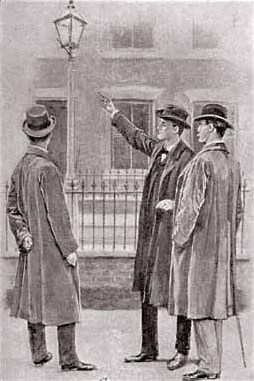
"The Adventure of the Six Napoleons", one of the 56 Sherlock Holmes short stories written by Sir Arthur Conan Doyle, is one of 13 stories in the cycle collected as The Return of Sherlock Holmes. It was first published in Collier's in the United States on 30 April 1904, and in The Strand Magazine in the United Kingdom in May 1904.

"The Adventure of the Norwood Builder", one of the 56 short Sherlock Holmes stories written by Sir Arthur Conan Doyle, is the second tale from The Return of Sherlock Holmes. The story was first published in Collier's (US) on 31 October 1903 and in The Strand Magazine (UK) in November 1903.
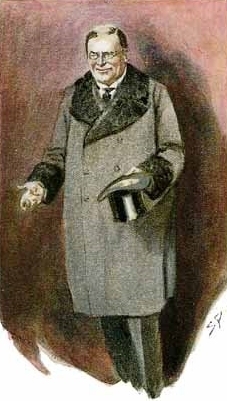
"The Adventure of Charles Augustus Milverton" is one of the 56 Sherlock Holmes short stories written by Sir Arthur Conan Doyle. It was originally published in Collier's in the United States on 26 March 1904, and in The Strand Magazine in the United Kingdom in April 1904. It is one of 13 stories in the cycle collected as The Return of Sherlock Holmes (1905).

Colonel Sebastian Moran is a fictional character in the stories written by Arthur Conan Doyle. An enemy of Sherlock Holmes, he first appears in the 1903 short story "The Adventure of the Empty House". Holmes once described him as "the second most dangerous man in London", the most dangerous being Professor Moriarty, Moran's employer.
Sherlock Holmes has long been a popular character for pastiche, Holmes-related work by authors and creators other than Arthur Conan Doyle. Their works can be grouped into four broad categories:
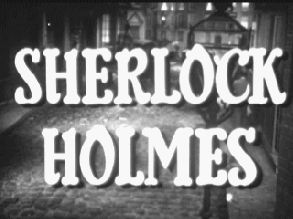
Sherlock Holmes was a detective television series syndicated in the autumn of 1954, based on the Sherlock Holmes stories of Arthur Conan Doyle. The 39 half-hour mostly original stories were produced by Sheldon Reynolds and filmed in France by Guild Films, starring Ronald Howard as Holmes and H. Marion Crawford as Watson. Archie Duncan appeared in many episodes as Inspector Lestrade. Richard Larke, billed as Kenneth Richards, played Sgt. Wilkins in about fifteen episodes. The series' associate producer, Nicole Milinaire, was one of the first women to attain a senior production role in a television series.
Sherlock Holmes and Dr. Watson is a 1979 Soviet film adaptation of Arthur Conan Doyle's novels about Sherlock Holmes. Directed by Igor Maslennikov, it is the first of a 5-part TV film series The Adventures of Sherlock Holmes and Dr. Watson. The film is divided into two episodes: "The Acquaintance" and "Bloody Inscription".
This article describes minor characters from the Sherlock Holmes stories by Sir Arthur Conan Doyle, and from non-canonical derived works. The list excludes the titular character as well as Dr. Watson, Professor Moriarty, Inspector Lestrade, Mycroft Holmes, Mrs. Hudson, Irene Adler, Colonel Moran, the Baker Street Irregulars, and characters not significant enough to mention.
"A Study in Pink" is the first episode of the television series Sherlock and first broadcast on BBC One and BBC HD on 25 July 2010. It introduces the main characters and resolves a murder mystery. It is loosely based upon the first Sherlock Holmes novel, A Study in Scarlet.

The Hound of the Baskervilles is a 1983 British made-for-television mystery thriller film directed by Douglas Hickox, starring Ian Richardson as Sherlock Holmes and Donald Churchill as Dr. John H. Watson. It is based on Arthur Conan Doyle's 1902 novel The Hound of the Baskervilles.
Sherlock Holmes or Puppet Entertainment Sherlock Holmes is a Japanese puppetry television series written by Kōki Mitani and produced and broadcast by NHK. The puppets for the series were designed by Bunta Inoue. The first series of 18 episodes was broadcast on Sundays from 12 October 2014 to 15 February 2015 by NHK Educational TV (ETV); the first six episodes were broadcast by NHK General TV (GTV) in March and August 2014. A special programme was broadcast on 5 October 2014 while a "Sherlock Holmes Award" was broadcast on 28 December 2014. Each episode was rebroadcast on successive Fridays. The programme won the Japan Sherlock Holmes Award on 22 March 2015.























